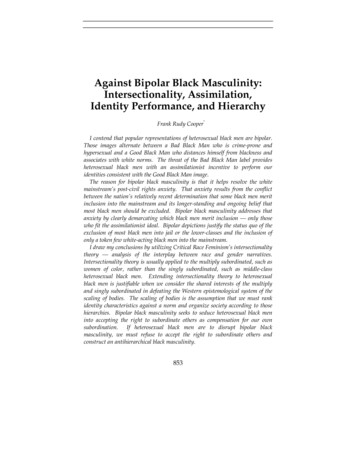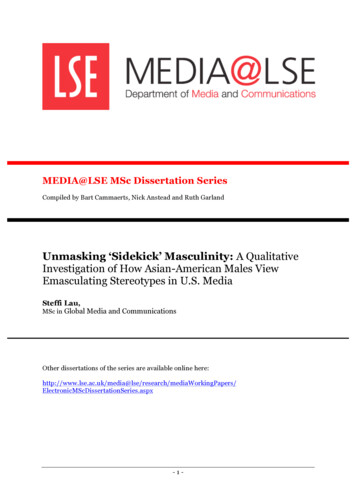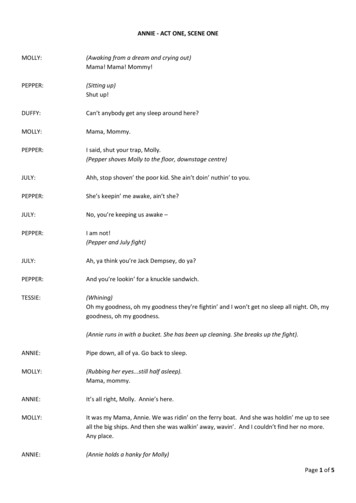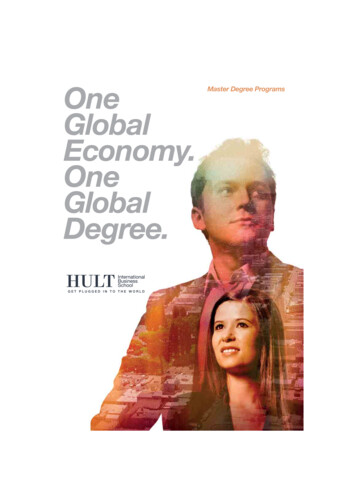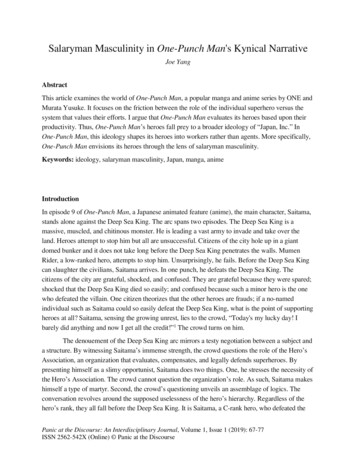
Transcription
Salaryman Masculinity in One-Punch Man's Kynical NarrativeJoe YangAbstractThis article examines the world of One-Punch Man, a popular manga and anime series by ONE andMurata Yusuke. It focuses on the friction between the role of the individual superhero versus thesystem that values their efforts. I argue that One-Punch Man evaluates its heroes based upon theirproductivity. Thus, One-Punch Man’s heroes fall prey to a broader ideology of “Japan, Inc.” InOne-Punch Man, this ideology shapes its heroes into workers rather than agents. More specifically,One-Punch Man envisions its heroes through the lens of salaryman masculinity.Keywords: ideology, salaryman masculinity, Japan, manga, animeIntroductionIn episode 9 of One-Punch Man, a Japanese animated feature (anime), the main character, Saitama,stands alone against the Deep Sea King. The arc spans two episodes. The Deep Sea King is amassive, muscled, and chitinous monster. He is leading a vast army to invade and take over theland. Heroes attempt to stop him but all are unsuccessful. Citizens of the city hole up in a giantdomed bunker and it does not take long before the Deep Sea King penetrates the walls. MumenRider, a low-ranked hero, attempts to stop him. Unsurprisingly, he fails. Before the Deep Sea Kingcan slaughter the civilians, Saitama arrives. In one punch, he defeats the Deep Sea King. Thecitizens of the city are grateful, shocked, and confused. They are grateful because they were spared;shocked that the Deep Sea King died so easily; and confused because such a minor hero is the onewho defeated the villain. One citizen theorizes that the other heroes are frauds; if a no-namedindividual such as Saitama could so easily defeat the Deep Sea King, what is the point of supportingheroes at all? Saitama, sensing the growing unrest, lies to the crowd, “Today's my lucky day! Ibarely did anything and now I get all the credit!”1 The crowd turns on him.The denouement of the Deep Sea King arc mirrors a testy negotiation between a subject anda structure. By witnessing Saitama’s immense strength, the crowd questions the role of the Hero’sAssociation, an organization that evaluates, compensates, and legally defends superheroes. Bypresenting himself as a slimy opportunist, Saitama does two things. One, he stresses the necessity ofthe Hero’s Association. The crowd cannot question the organization’s role. As such, Saitama makeshimself a type of martyr. Second, the crowd’s questioning unveils an assemblage of logics. Theconversation revolves around the supposed uselessness of the hero’s hierarchy. Regardless of thehero’s rank, they all fall before the Deep Sea King. It is Saitama, a C-rank hero, who defeated thePanic at the Discourse: An Interdisciplinary Journal, Volume 1, Issue 1 (2019): 67-77ISSN 2562-542X (Online) Panic at the Discourse
68 J. YANGDeep Sea King. Yet the sequence is only briefly jovial. By sacrificing his reputation, Saitamaupholds the ideology of the hero's association. Such an ideology extends beyond the story of OnePunch Man. This ideology is one of masculinity, in particular, referring to salaryman masculinity.One-Punch Man, as a cynical take on superheroes, reveals how pervasive such an ideology is incontemporary Japan.One-Punch Man and Superheroes in JapanOne-Punch Man refers to various media properties. It began as a webcomic by ONE. It then becamea collaboration between ONE and Murata Yusuke for Weekly Shonen Jump. It was then adaptedinto an anime by Studio Madhouse. ONE intended for the comic to test out how to draw comics.2ONE’s intentions were to publish these comics on Nitosha, a free publishing platform for comics.Since the comic began as an experiment, One-Punch Man’s initial art style was crude andsimplistic. ONE rendered characters in full black and white with thick lines. The resolutions weresmall and the designs were simple. One-Punch Man exploded in popularity when manga artistMurata Yusuke (Eyeshield 21) came across the webcomic. According to ONE in a Weekly ShonenJump interview, “Murata Sensei just happened to find my website and became interested in OnePunch Man. I had always been a fan of his, so I jumped at the opportunity to work with him. I getreally excited seeing my work transformed into something with so much passion and amazing art.”3Murata is largely the artist for the manga collaboration. Through the collaboration, the characterdesigns have become well-defined and the heroes, intricate. Overall, the manga was much morevisually complex. Yet the collaboration between ONE and Murata runs deeper than a writer-artistcollaboration. Murata became involved in writing the collaborative One-Punch Man manga. Theresult was Shonen Jump-specific arcs that never appeared in the original webcomic. Likewise, bothONE and Murata played clear advisory roles for the One-Punch Man anime.Despite the minor differences between all three, the narrative structure of One-Punch Manremains consistent. One-Punch Man concerns a penniless superhero named Saitama. After saving ayoung child from a crab monster, Saitama develops a taste for herodom. Thus, he undergoes arigorous training regiment: 100 push-ups, 100 squats, 100 crunches, and running 10 kilometers aday, no exceptions. According to Saitama, there were two by-products: hair loss and insurmountablephysical ability. Well into his hero career, he meets Genos, a cyborg. Genos introduces Saitama tothe Hero's Association, an institutional body that financially supports and regulates heroes. It turnsout that Saitama's lack of notoriety is because he never enlisted in the Hero's Association. Despitehis immense physical prowess, Saitama nearly fails the written examination. As such, while he is byfar the strongest character in the series, he begins as a C-rank hero.4 The story of One-Punch Manconcerns his efforts to climb the ranks.Why is One-Punch Man an important case? There are two reasons. First, Japan, comparedto America, has a much more fractured image of the superhero. At a glance, there is a clearerPanic at the Discourse: An Interdisciplinary Journal
SALARYMAN MASCULINITY IN ONE-PUNCH MAN 69homology of superheroes in America. Images of Batman, Superman, the Avengers, and othercharacters from the DC and Marvel comic universes, are clearly marketed and delineated assuperheroes. Such superheroes, according to Chris Gavaler, refer to older stories of agentialexceptionalism. To Gavaler, “[b]efore the dawn of election ballots, kings represented God and soruled by divine right. When God retired from politics, supermen claimed the empty throne. Evenwhen they allow some petty president or prime minister to sit on it, superheroes.pledge allegianceto no government.”5 Thus the image of the superhero in American comics (partially) recallssentiments of famous revolutionaries like Guy Fawkes and Oliver Cromwell, whose moral compassand political orientation were not supposed to be beholden to any government. Gavaler also notesthat superheroes are free agents, “radicals championing their own self-defined liberty.”6 Exceptionalstatus and ability go together with exceptional capacity. In Japan, such characters do exist.However, they are not usually referred to as superheroes. Son-Goku from Akira Toriyama's DragonBall, for instance, is an individual of exceptional ability. A savant of combat, Goku's journeys arereminiscent of American superheroes. Goku has enemies, allies, and fights for what he believes isright or true. His immense physical prowess undergirds his ability to enact his morals. However,Goku is not marketed as a superhero. In Japan, characters like Goku, Ichigo (from Bleach), Luffy(from One Piece), or Naruto (from Naruto) act akin to superheroes. However, they are almost nevermarketed as superheroes, nor do audiences perceive them as superheroes. The cultural distinctionbecomes even more complex when looking at adjacent or subcultural texts. Takeuchi Naoko'sBishojo Senshi Sera Mun (Sailor Moon) concerns a group of schoolgirls who transform intocostumed fighters and combat evil. Here, Sailor Moon falls in the lineage of Super Sentai (Sentaimeaning “task force”) shows. In Super Sentai, a team of heroes work together to fight off threats.Super Sentai itself is a form of tokusatsu (“special effects”) television, many of which involvesuperheroes. The result is both a market and a field of study that bears a different registry in Japan.Many of these characters do not fall under the category of superhero. Instead, these characters fallunder nekketsu (hot-blooded), shounen (young boy), mahou shoujo (magical girl), among others.Japan’s heterogenous look at the superhero is crucial. Despite its fractured image of thesuperhero, Japan does have its own superhero genre. Furthermore, the Japanese superhero genre isfully aware of its American influences. The Japanese superhero genre bears significant cross-Pacificinfluence with America. Thus, on some level, it bears occidental undertones. Kohei Horikoshi’s MyHero Academia is a chart-topping manga and anime series about students with powers. Horikoshinoted that he was influenced by Marvel comics, specifically Spiderman.7 While billed as tokusatsu,Tsurubaya Eiji’s Ultraman reflexively refers to itself as a ‘hero.’ And while Japan does havenumerous hero-related subgroups, one of the earliest contemporary television tokusatsu was ToeiCompany’s loose adaptation of Spiderman. This adaptation, which ran from May 17, 1978 to March14, 1979, is Spiderman in name and costume only. In fact, One-Punch Man is a direct play onwords of an earlier Japanese superhero story, Anpanman. Saitama himself is a reference toAnpanman, a hero whose head is a bean jam bun. One-Punch Man bears lineage of JapanesePanic at the Discourse: An Interdisciplinary Journal
70 J. YANGsuperheroes that call attention to their herodom. While the characters in the previous paragraphfulfill the roles of heroes, they rarely identify nor are they marketed as superheroes. Properties suchas My Hero Academia and One-Punch Man directly refer to its own characters as superheroes. Theimportance of this distinction is that there is an acknowledgement and understanding of thesuperhero. Recalling Goku, even though he acts like a superhero, he is not sold or understood as asuperhero.One-Punch Man as a Kynical TextThis leads to the second point. While My Hero Academia employs a complex system ofsuperheroes, One-Punch Man foregrounds its own self-reflexivity. Both texts involve systems ofhero-dom. Both texts involve characters whose central drama concerns navigating those systems.Both texts, in such dramas, make statements on the necessity of those systems. One-Punch Mandiffers from My Hero Academia because One-Punch Man is self-reflexive. One-Punch Manengages with the nature of what makes a hero. At the same time, asking what makes a heroreinforces its ideology. It is a kynical text. Peter Sloterdijk popularized the term in In Critique ofCynical Reason. He argues that when we consider ideological critique, such considerations bear a“polemical continuation of the miscarried dialogue through other means.”8 For Sloterdijk, critiqueof ideology already takes on the form of respectability. Yet such respectability is insufficient forproper critique. Drawing on Diogenes, Sloterdijk argues that sufficient critique requires a cheeky,playful challenge to idealistic critiques of ideology. Sloterdijk's kynical reasoning is reminiscent ofBakhtin's carnival: a cheeky, playful space in which systems invert. Building on Sloterdijk, Žižekproposes that such kynical texts draw cynical reasons. For Žižek, whereas the kynic is an embodiedvulgarity that challenges idealistic systems, the cynic presupposes such an engagement and operateswithin such systems. The cynic, in other words, is aware they are a subject of an ideology. They arethus aware of Marx's basic ideological tenet: “they do not know it, but they are doing it.”9 In fact,cynical subjects of an ideology know they are doing it, but they do it anyways. In doing so, thecynical text is ideology par excellence. In believing they are aware of how ideology shapes them,they become comfortable. Doing so reinforces their ideology. For One-Punch Man, there is no clearcynicism. Neither ONE nor Murata has made any pretenses about the critique of ideology; yet, thetext bears several critiques (which will be addressed later). In short, One-Punch Man engages inplayful dismantling of power structures. At the same time, it provides no clear answers on how tonegotiate the ideology of its heroes.This kynical attitude pervades One-Punch Man. The rhetoric and deflation of Garou is onesuch example. A rogue agent, Garou prowls the cities and engages in what he calls a “hero hunt.”The hero hunt is where Garou challenges heroes to test his power and skill. He is often victorious.The hero hunt is so successful, in fact, that the Hero's Association sends out an organization-widebounty. Everyone is after Garou, now dubbed as “the human monster.” The arc climaxes at thePanic at the Discourse: An Interdisciplinary Journal
SALARYMAN MASCULINITY IN ONE-PUNCH MAN 71showdown. Several heroes and monsters are in a pitched battle. Garou is in the fray and he isseverely wounded. In chapter 68 of the webcomic, while wounded, Garou laments to one of theheroes:Garou: Aren't you playing 'hero' as well? It reeks of hypocrisy, it makes me sick. Whatyou're doing now is also part of 'conducting justice and punishing evildoers'? As long as youdo the right thing, you gain power, right? That's powerful, sure. Humans conductingviolence with no regret or guilt, they can beat anyone. If needed, just throw that kindnessoverboard. You heroes are shit.10Chapters later, he is defeated. But such precarity unlocks a power within him. He reaches aphysical apotheosis, and, ascended, disposes of the heroes and monsters with ease. The arc reachesits nadir, with all hope lost, until Saitama comes to the fray. Saitama's entrance is a visual gag: hisap
Company’s loose adaptation of Spiderman. This adaptation, which ran from May 17, 1978 to March 14, 1979, is Spiderman in name and costume only. In fact, One-Punch Man is a direct play on words of an earlier Japanese superhero story, Anpanman. Saitama himself is a reference to Anpanman, a hero whose head is a bean jam bun.

